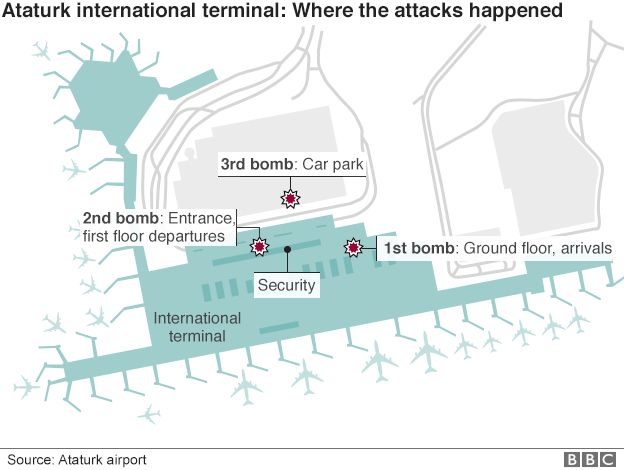On January 6, 2017, a shooter at the Fort Lauderdale – Hollywood Airport killed five people and injured six more, inciting mass panic at the airport. The shooting took place near baggage claim – a vulnerable location because large groups of people congregate in the space and it is just outside of the secured portion of the airport. On a recent trip to this same Fort Lauderdale airport, an SEC consultant observed the behavior of the public in the area of the attack. As is typical in baggage claim areas, our consultant noted individuals clustered around the baggage carousel, immersed in conversations with family and friends, or scrolling through their cell phones. Although it is a testament to the American spirit that we do not live in constant fear, it is important for people to recognize that certain locations are susceptible to threats. Security perimeters are established to protect people and buildings, but we must accept that the areas just outside of these perimeters have been the site of attacks, and unfortunately, will likely be targets for attacks in the future.
On May 22, 2017, a suicide bomber killed 22 people and injured dozens more leaving an Ariana Grande concert in Manchester, England. Like the Fort Lauderdale shooting, the bombing occurred right outside of the security perimeter for the concert. It was strategically timed at the end of the concert for when large numbers of audience members would be streaming out of the secured entryway. Manchester and Fort Lauderdale are only two examples of attacks that have occurred on the perimeter of secured areas. As part of the coordinated November 2015 Paris terrorist attacks, three suicide bombers detonated outside the Stade de France stadium during a soccer match between France and Germany. On June 28, 2016, attacks at an airport in Istanbul killed 41 and injured 230. Three bombs exploded in different spots around the airport, but all three were outside of the security perimeter. A similar attack occurred on March 22, 2016, at the Brussels airport. Two bombs exploded at the check-in areas on different sides of the airport, killing 32 people.
Certain venues, especially ones that attract large crowds and/or have cultural significance, have a greater likelihood of being attacked. Domestic and international law enforcement and security professionals have attempted mitigate the risk by deploying comprehensive security measures at likely targets such as airports, concert halls, museums, sporting events, theme parks, festivals and historic landmarks. Security officials continue to enhance and evolve the tools and tactics they utilize to protect these areas, but the problem remains – there will always be vulnerabilities associated with the spaces that are just outskirts of these perimeters. Ultimately, the security perimeter has to stop somewhere.
In recent years, security and law enforcement officials have recognized this threat and have taken a variety of actions to help mitigate the danger. One example is the practice of deploying canine units that can detect the compounds commonly found in explosive devices. The Secret Service, for example, uses this type of unit in areas where the public gather outside the White House fence line. Many agencies and organizations with protective responsibilities have enhanced their capabilities by employing integrated technologies like smart surveillance cameras, license plate readers, radiological detectors and gunshot detector systems.
Another tactic commonly used by law enforcement entities is the injection of plain-clothed surveillance teams on the lookout for suspicious behavior. Conversely, in some cities, uniformed law enforcement officers do random surges to specific areas of their jurisdiction. The New York Police Department, for instance, has an elite counterterrorism team called the “Hercules Team,” that, on a regular basis, floods different parts of the city at unannounced times.
While law enforcements’ efforts have enhanced security in the areas beyond security perimeters, the cameras, canines, and officers cannot be everywhere at once. There are, though, concrete things everyday citizens can do to enhance their safety in these types of environments. Situational awareness is key. People must always have a strong understanding of where they are, what is going on around them, and what their evacuation options are should they need to escape. Here are a few concrete things to consider:
- Position yourself strategically in the crowd: Don’t be like the people at the Fort Lauderdale baggage claim, crowded together looking at their phones exhibiting little or no situational awareness. Consider your position in relation to other people, to areas that could provide cover or concealment, and most importantly, to avenues of escape. Are you exposed to vulnerable glass that could become shrapnel during an explosion? Are you in an area where you could be exposed to a vehicle assault from a high-speed avenue of approach? Many times, just making a small difference in your position can mitigate or neutralize your vulnerability to a variety of threats.
- Know your evacuation routes: Always think to yourself, “If I need to, how can I get out?” Understand all of your options. In emergency situations, people often reflexively try to exit the way they came entered, even though there are often better options. When people are panicked, stampedes and exit blockages can occur as it did in the 2003 Stadium nightclub fire in East Warwick, RI when 100 people tragically perished. By understanding all of your evacuation options and not just following the crowd, you can greatly enhance your ability to safely escape from an emergency situation.
- Find cover and concealment: To find “cover” means to hide behind something that could protect you, like a brick wall. Finding “concealment” would be hiding behind something like a curtain, that shields you from view, but would not physically protect you. Doing a quick survey of your environment to identify spaces in close proximity that would provide you greater protection in the event of an attack, will facilitate getting to you to that space quicker if you need to.
- What can you use as a weapon? In the event you come into contact with the attacker, as a last resort use whatever is around to protect yourself and others. In the recent London Bridge attacks, there were reports of restaurant patrons throwing glass, silverware, and crates when the terrorists came into the restaurant.
As we head into the summer travel season, many of us will find ourselves with friends and family at locations that have robust security perimeters. This purpose of this post is not to try to deter people from attending sporting events and concerts, or from visiting theme parks and museums. Our unwillingness to bend to terrorists who want to have us cowering in fear is an important part of the fabric of our country. Additionally, our intelligence, law enforcement and other security professionals do a remarkable job not only by securing these locations and events, but also disrupting plots before attacks can even occur.
As aware citizens, we can recognize that vulnerabilities exist, especially in the areas beyond the established security perimeters. By exhibiting some situational awareness and considering response options prior to an incident, people can significantly increase the likelihood of successfully navigating an emergency situation.

